Nori is an indispensable element of any sushi meal. At first glance, the black sheets of dried seaweed may look unappetizing, but nori is a healthy, nutritious sea vegetable. The type called Asakusa nori was once synonymous with nori, but is now fast disappearing.
The primary countries with nori-eating cultures in the world today are Japan, South Korea, and parts of China. In Japan, nori is a handy food item that is either used to wrap balls or rolls of rice or sliced into thin strips and sprinkled over various food items as a condiment. In the past, Westerners unfamiliar with nori were surprised to see Japanese people eating "black paper." But today, nori is widely recognized as a health food derived from the sea, and it can be found on the shelves of most natural food shops and supermarkets in the United States.
When Japanese people hear the word "nori," most conjure up images of Asakusa nori. But the type that is sold today is invariably the type called Susabi nori, as it is almost impossible to find Asakusa nori on the market today.
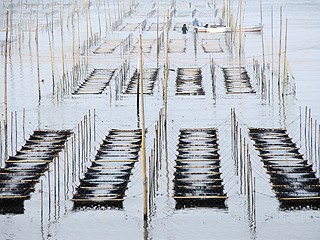
My personal impression is that the taste of nori today is not what it used to be. It tends to have a deep, wonderful luster, to be sure, but there is very little fragrance, and it tends to stick to one's teeth. When stroked over a flame, the nori of yesteryear gave off a faint scent of the sea and would melt in one's mouth. These were the qualities of Asakusa nori, which has all but disappeared, although there remain a handful of people who are working to keep it alive.
Origins
Nori in Korean is called gim , which grows from spores on underwater rocks and branches of sea plants. According to Chosen shokubutsu-shi (The Flora of Korea) by Korean culinary expert Chun Daesong, nori first entered Japan in the late sixteenth century following a military expedition to Korea by warlord Toyotomi Hideyoshi. Nori was reportedly brought back to Japan, first to Hiroshima and eventually to Edo (present-day Tokyo), after which nori aquaculture began in Tokyo Bay.
Great progress was made in aquaculture techniques following World War II. Nori is harvested much like green tea, with only freshly grown "sprouts" being plucked. Sprouts are soft while young, but they harden as they grow. Harvest periods are very short and yields small if the process is left completely to nature.
Thus a method was developed to prolong the harvest period. Seedlings on nets are lowered into the sea until they grow to around 3 to 4 centimeters. They are then drawn up and preserved in a frozen state. When the nets are lowered into the sea again, the nori starts growing again. This method has more than doubled nori's harvest period.
The Disappearance of Asakusa Nori
Nori usually refers to amanori (genus Porphyra ), of which the Asakusa variety was once quite common. Most amanori freshly harvested off Japan's coast has a sweet aroma and a faintly sweet taste, giving rise to its name ( amanori means "sweet nori"). Most amanori is found along the Pacific coast, in the Seto Inland Sea, and on the northwest shores of Kyushu in the upper intertidal. It is most commonly seen near river mouths, where water tends to have lower salinity.
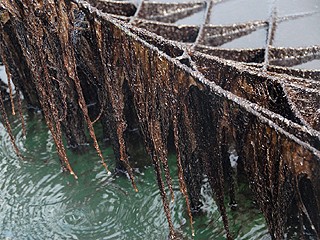
Asakusa nori is extremely vulnerable to changes in temperature and to seawater contamination and is highly susceptible to disease. It may only be natural, then, that this type gradually disappeared as pollution grew more serious in Japan.
The main type of nori cultivated in the country thus became Susabi nori, which was originally found along the western coast of Hokkaido and in seas off the Tohoku district. It is not as soft as Asakusa nori and is not as delicious, but it has a deep, black luster; it can be grown in harsher conditions and produces bigger yields due to its longer harvest period.
Most nori sold in Japan today is Susabi nori. It is inexpensive, fast growing, can be produced in abundance, and has an attractive appearance. It can be machine rolled tightly without tearing and is therefore widely used to wrap the onigiri sold at convenience stores, in box lunches, and at kaiten (conveyor-belt) sushi restaurants. Most nori aquafarms have embraced modern technology, relying on large machines to mass-produce nori at low cost. Gone are the days when nori producers gave top priority to taste and quality as they handpicked, hand-produced, and sun-dried their nori in the traditional manner.
Marine Agrochemicals
To grow, nori needs seawater nutrients and sunlight. It is cultured on nets lowered to optimum depths with poles inserted into the seabed. The frames of the nets serve a purpose much like the ridges along the edges of rice paddies. Cultured nori needs to be dried for several hours each day, and this was once done as the nets appeared above water during low tide.
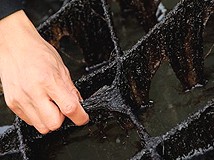
Growth stops while nori is out of the water, though, thus lowering productivity. This problem is now generally averted by a process called acid treatment, whereby the nori attached to nets is soaked in an acidic solution. This is essentially a marine agrochemical. Only organic acids are to be used, according to an agreement among nori farmers, and the leftover acidic solution must be brought back to land for neutralization and disposal. But in actual practice, hydrochloric, sulfuric, and phosphoric acids-which are inorganic, cheaper, and more effective-have been widely used. The acidic solution is also often illegally dumped into the sea after use.
Susabi nori is resistant to acid treatment, though, and still develops a deep black luster. Asakusa nori, on the other hand, is easily damaged by acids. The last remaining Asakusa nori aquafarms are fast disappearing as seawater becomes contaminated with not only pollutants but also acids used in the treatment of Susabi nori.
Shigemi Koga, an Asakusa Nori Grower
Growing Asakusa nori without acid treatment requires the use of healthy seeds. Shigemi Koga (58) thus frequently visits a fisheries research center that cultivates a type of Asakusa nori called Noguchi in June to check the growth of seedlings. In September he prepares the breeding grounds by inserting metal poles that will hold the nets, and in mid-October, when seawater is around 22 to 23 degrees, he releases the spores. If seawater temperatures rise too high, the seedlings will die. To each net he hand-ties small bags of oyster shells that contain nori filaments. This is a task that continues from early morning to late at night with the help of many colleagues.
The bags of oyster shells are not attached directly to the nets, but to bamboo sticks fitted to the nets. When this task is completed, the nets are placed on ships and carried to the sea. The nets are then tied firmly to the metal poles to create "fields" of nori.
To produce healthy nori, it is important not to plant it too densely. Creating space between the "fields" allows the tide to flow through, helping prevent disease.
Between 35 and 39 days after planting, the nori should be ready for the first harvest. The initial yield is soft, so nori is hand-plucked, hand-laid into sheets, and hand-dried in the sun. Nori at around this age grows by 3 centimeters per day. It is checked for growth and softness with ungloved hands and then handpicked. The water is cold, so the hands often become numb, making the harvest a time-consuming process.
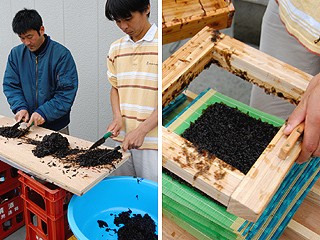
Right: Water is added to create a paste, which is spread thinly over a bamboo mat with the aid of a wooden frame.
The waters off Fukunoehama in the city of Izumi, Kagoshima Prefecture, remain shallow for around 600 meters, so nori can be harvested standing up, although this is not easy since water comes up above the waist. The hand-plucked nori is carried to land, washed, and cut into small pieces. Water is added to create a paste, which is then spread thin over a wooden board using a wooden cup. This is a task requiring great skill in order to perform quickly and to achieve evenness.
The boards with the spread-out paste are placed in a dryer, and the sheets are then removed and hung on a wooden frame. The drying of sheets begins at dawn the next morning and continues for about four hours; when they turn crisp, they give off a faint crackling sound.
"It's as if the nori sheets are telling me, 'We're ready!'" claims Koga. He claims that he can produce only around 500 sheets of sun-dried nori a day, even with the help of extra hands. With state-of-the-art machinery, on the other hand, it is possible to produce 30,000 sheets a day, and the entire drying process, including bundling for shipment, takes only four hours.
Koga, in fact, is the only person in Japan who continues to make nori in the time-honored manner without the aid of machines.
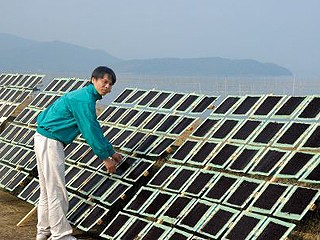
Asakusa nori grows quickly. Producing soft, high-quality nori is a process that takes around one month. Thus when other nori growers reach peak production, Koga is generally nearly finished for the season.
The Noguchi variety of Asakusa nori that he grows-which does not require acid treatment-is native to the region. It is light and crispy, and when eaten it melts in one's mouth and gives off a faint aroma. It is a taste from the past that has become a very rare treat today.
Preserving Asakusa Nori
There are others in Kyushu's Ariake Bay-where Susabi nori has become the norm-besides Koga who are at least choosing not to cave in to the acid treatment trend in an effort to keep Asakusa nori aquaculture alive.
Keiji Shimauchi of Nishiyoga, Saga Prefecture, is the leader of a group of 16 nori growers dedicated to preserving "good-tasting nori." Saga was once famed for its high-quality, flavorful nori.
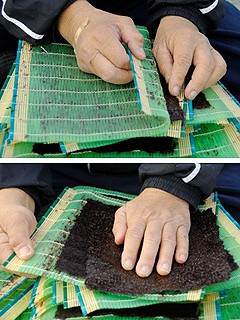
High-quality Asakusa nori is crisp and gives off a faint smell of the sea.
Most area nori farmers were against the introduction of acid treatment, but outbreaks of disease caused yields to diminish, threatening their livelihoods. They therefore had no choice but to lift the ban on acid treatment 14 years ago. Shimauchi resisted the move, however, out of deference to tradition and also because he had seen how acid was polluting the coastal waters.
But even Shimauchi gave up producing Asakusa nori this season. He notices abnormalities emerging in the growth of his nori. For instance, Susabi nori has begun to invade the areas where the weaker Asakusa variety is being grown. The latter will not completely disappear anytime soon, though, as he has a stock of seeds of the original strain.
Shimauchi will likely be growing Asakusa nori again next season, though-without resorting to acid treatment. While he had contemplated introducing the treatment, he changed his mind when he sought the advice of a local expert, Shigeyoshi Koga.
"Don't rely on the treatment," Koga told him succinctly. "Nori doesn't need acids to grow, it needs love." (This Article was first published on September 1, 2008)
Research Adviser
Presides over the "Shoku no Gakko" Natural Food Association. Is actively involved in establishing networks of food producers and distributors around Japan.
Photos: Kazuo Kikuchi
